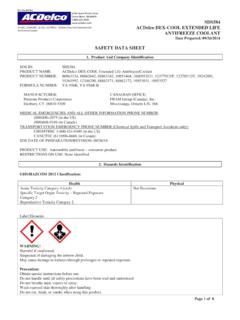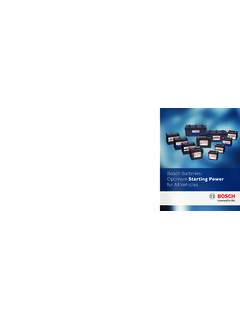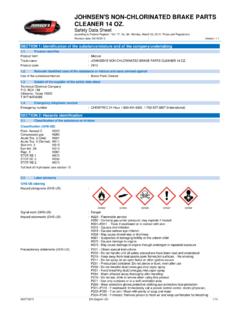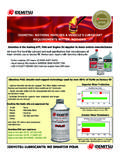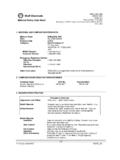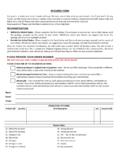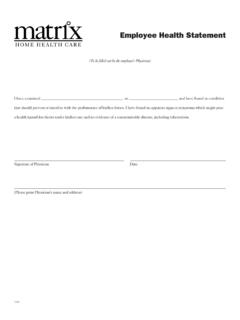Transcription of Page: 1 SAFETY DATA SHEET Revision Date: 06/17/2011 ...
1 Page: 1 safety data sheet revision date : 06/17/2011 MERCEDES-BENZ PART # BQ1030004 print date : 2/6/2013 MSDS Number: R0296767 Mercedes Benz G-48 ANTIFREEZE COOLANT 798694 Version: Page 1 / 13 1. IDENTIFICATION OF THE SUBSTANCE/MIXTURE AND OF THE COMPANY/UNDERTAKING Ashland Regulatory Information Number 1-800-325-3751 Box 2219 Telephone 614-790-3333 Columbus, OH 43216 Emergency telephone number 1-800-ASHLAND (1-800-274-5263) Product name Mercedes Benz G-48 ANTIFREEZE COOLANT Product code 798694 Product Use Description No data 2. HAZARDS IDENTIFICATION Emergency Overview Appearance: liquid, blue WARNING! MAY AFFECT THE CENTRAL NERVOUS SYSTEM CAUSING DIZZINESS, HEADACHE OR NAUSEA. CAUSES EYE IRRITATION. HARMFUL IF SWALLOWED. Potential Health Effects Exposure routes Inhalation, Skin absorption, Skin contact, Eye Contact, Ingestion Eye contact Can cause severe eye irritation.
2 Symptoms include stinging, tearing, redness, and swelling of eyes. Can injure eye tissue. Skin contact May cause mild skin irritation. Symptoms may include redness and burning of skin. Skin absorption of this material (or a component) may be increased through injured skin. Ingestion Swallowing this material may be , kidney and brain damage in humans has resulted from swallowing lethal or near-lethal amounts of ethylene of medications contaminated Page: 2 SAFETY data SHEET Revision date : 06/17/2011 print date : 2/6/2013 MSDS Number: R0296767 Mercedes Benz G-48 ANTIFREEZE COOLANT 798694 Version: Page 2 / 13 with diethylene glycol has caused kidney failure and death in humans. Products containing diethylene glycol should be considered toxic by ingestion. Inhalation It is possible to breathe this material under certain conditions of handling and use (for example, during heating, spraying, or stirring).
3 Breathing small amounts of this material during normal handling is not likely to cause harmful effects. Breathing large amounts may be harmful. Symptoms are not expected at air concentrations below the recommended exposure limits, if applicable (see Section 8.). Aggravated Medical Condition Preexisting disorders of the following organs (or organ systems) may be aggravated by exposure to this material:, lung (for example, asthma-like conditions), Liver, Kidney, Central nervous system, Exposure to this material may aggravate any preexisting condition sensitive to a decrease in available oxygen, such as chronic lung disease, coronary artery disease or anemias. Symptoms Signs and symptoms of exposure to this material through breathing, swallowing, and/or passage of the material through the skin may include:, stomach or intestinal upset (nausea, vomiting, diarrhea), irritation (nose, throat, airways), Cough, central nervous system excitation (giddiness, liveliness, light-headed feeling) followed by central nervous system depression (dizziness, drowsiness, weakness, fatigue, nausea, headache, unconsciousness) and other central nervous system effects, involuntary eye movement, pain in the abdomen and lower back, cyanosis (causes blue coloring of the skin and nails from lack of oxygen), lung edema (fluid buildup in the lung tissue), acute kidney failure (sudden slowing or stopping of urine production), liver damage, Convulsions, coma Target Organs Overexposure to this material (or its components) has been suggested as a cause of the following effects in laboratory animals.
4 , reproductive effects, kidney damage, liver damage, central nervous system damage, Overexposure to this material (or its components) has been suggested as a cause of the following effects in humans:, liver damage, kidney damage Carcinogenicity This material is not listed as a carcinogen by the International Agency for Research on Cancer (IARC), the National Toxicology Program (NTP), or the Occupational SAFETY and Health Administration (OSHA). Reproductive hazard Ethylene glycol has caused birth defects in animal studies at high oral doses. However, it did not cause harm to the pregnant animal or to the fetus when applied to the skin of the pregnant animal., This Page: 3 SAFETY data SHEET Revision date : 06/17/2011 print date : 2/6/2013 MSDS Number: R0296767 Mercedes Benz G-48 ANTIFREEZE COOLANT 798694 Version: Page 3 / 13 material (or a component) has been shown to cause harm to the fetus in laboratory animal studies.
5 Harm to the fetus occurs only at exposure levels that harm the pregnant animal. The relevance of these findings to humans is uncertain. 3. COMPOSITION/INFORMATION ON INGREDIENTS Hazardous Components CAS-No. Concentration ETHYLENE GLYCOL 107-21-1 >=90-<=100% DIETHYLENE GLYCOL 111-46-6 >= <5% 2-ETHYLHEXANOIC ACID, SODIUM SALT 19766-89-3 >= <5% 4. FIRST AID MEASURES Eyes If symptoms develop, immediately move individual away from exposure and into fresh air. Flush eyes gently with water for at least 15 minutes while holding eyelids apart; seek immediate medical attention. Skin Remove contaminated clothing. Wash exposed area with soap and water. If symptoms persist, seek medical attention. Launder clothing before reuse. Ingestion Seek medical attention. If individual is drowsy or unconscious, do not give anything by mouth; place individual on the left side with the head down.
6 Contact a physician, medical facility, or poison control center for advice about whether to induce vomiting. If possible, do not leave individual unattended. Inhalation If symptoms develop, immediately move individual away from exposure and into fresh air. Seek immediate medical attention; keep person warm and quiet. If person is not breathing, begin artificial respiration. If breathing is difficult, administer oxygen. Notes to physician Page: 4 SAFETY data SHEET Revision date : 06/17/2011 print date : 2/6/2013 MSDS Number: R0296767 Mercedes Benz G-48 ANTIFREEZE COOLANT 798694 Version: Page 4 / 13 Hazards: Effects of acute ethylene glycol poisoning appear in three fairly distinct stages. The initial stage occurs shortly after exposure, lasts 6-12 hours, and is characterized by central nervous system effects (transient exhilaration, nausea, vomiting, and in severe cases, coma, convulsions, and possible death).
7 The second stage lasts from 12-36 hours after exposure and is initiated by the onset of coma. This phase is characterized by tachypnia, tachycardia, mild hypotension, cyanosis, and in severe cases, pulmonary edema, bronchopneumonia, cardiac enlargement, and congestive failure. The final stage occurs 24-72 post-exposure and is characterized by renal failure, ranging from a mild increase in blood urea nitrogen and creatinine followed by recovery, to complete anuria with acute tubular necrosis that can lead to death. Oxaluria is found in most cases. The most significant laboratory finding in ethylene glycol intoxication is severe metabolic acidosis. Ingestion or other significant exposure to this material (or a component) may cause metabolic acidosis. Treatment: This product contains ethylene glycol. Ethanol decreases the metabolism of ethylene glycol to toxic metabolites. Ethanol should be administered as soon as possible in cases of severe poisoning since the elimination half-life of ethylene glycol is 3 hours.
8 If medical care will be delayed several hours, give the patient three to four 1-ounce oral "shots" of 86-proof or higher whiskey before or during transport to the hospital. Fomepizole (4-methylpyrazole) is an effective antagonist of alcohol dehydrogenase, and as such, may be used as an antidote in the treatment of ethylene glycol poisoning. Hemodialysis effectively removes ethylene glycol and its metabolites from the body. 5. FIRE-FIGHTING MEASURES Suitable extinguishing media Dry chemical, Carbon dioxide (CO2), Water spray Hazardous combustion products Alcohols, Aldehydes, carbon dioxide and carbon monoxide, ethers, toxic fumes, Hydrocarbons Precautions for fire-fighting Wear full firefighting turn-out gear (full Bunker gear), and respiratory protection (SCBA). DO NOT direct a solid stream of water or foam into hot, burning pools of liquid since this may cause frothing and increase fire intensity.
9 Frothing can be violent and possibly endanger any firefighter standing too close to the burning liquid. Use water spray to cool fire exposed containers and structures until fire is out if it can be done with minimal risk. Avoid spreading burning material with water used for cooling purposes. NFPA Flammable and Combustible Liquids Classification Combustible Liquid Class IIIB Page: 5 SAFETY data SHEET Revision date : 06/17/2011 print date : 2/6/2013 MSDS Number: R0296767 Mercedes Benz G-48 ANTIFREEZE COOLANT 798694 Version: Page 5 / 13 6. ACCIDENTAL RELEASE MEASURES Personal precautions For personal protection see section 8. Persons not wearing protective equipment should be excluded from area of spill until clean-up has been completed. Environmental precautions Prevent spreading over a wide area ( by containment or oil barriers). Do not let product enter drains.
10 Do not flush into surface water or sanitary sewer system. Methods for cleaning up Keep in suitable, closed containers for disposal. Soak up with inert absorbent material ( sand, silica gel, acid binder, universal binder, sawdust). Other information Comply with all applicable federal, state, and local regulations. 7. HANDLING AND STORAGE Handling Containers of this material may be hazardous when emptied. Since emptied containers retain product residues (vapor, liquid, and/or solid), all hazard precautions given in the data SHEET must be observed. Storage Store in a cool, dry, ventilated area. 8. EXPOSURE CONTROLS/PERSONAL PROTECTION Exposure Guidelines ETHYLENE GLYCOL 107-21-1 ACGIH Ceiling Limit Value: 100 mg/m3 Aerosol. DIETHYLENE GLYCOL 111-46-6 WEEL time weighted average 10 mg/m3 General advice Page: 6 SAFETY data SHEET Revision date : 06/17/2011 print date : 2/6/2013 MSDS Number: R0296767 Mercedes Benz G-48 ANTIFREEZE COOLANT 798694 Version: Page 6 / 13 These recommendations provide general guidance for handling this product.


